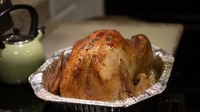Prairie Fare: Let’s Talk Food Safety
(Click an image below to view a high-resolution image that can be downloaded)
By Julie Garden-Robinson, Food and Nutrition Specialist
NDSU Extension
“When is the turkey going to be ready?” someone asked.
I opened the oven and admired the glistening, nicely browned bird proudly.
I planned to make some gravy from the drippings. With a little help, I lifted the turkey onto a serving tray.
The turkey was clutching its wings to its chest. Upon removal from the pan, the wings popped up, exposing its “wing pits.” The sides of the turkey were pale.
Unfortunately, I had squeezed the large bird into an undersized pan.
The turkey measured an undercooked 135 degrees instead of the recommended 165 degrees. The juices were pinkish and certainly did not run clear.
Now I was nearly clutching my chest. I felt a little pale and sickly myself. All the side dishes were ready but the star of the meal wasn’t done.
“Put it in the microwave,” someone suggested.
That would have required me to wedge a 15-pound bird into a small appliance.
Needless to say, my guests had to wait awhile when the turkey was placed back in the oven on a tray.
I could have ended my future career as a food safety specialist if I had sickened my entire family.
Undercooked poultry may be contaminated with salmonella or campylobacter bacteria, but proper cooking inactivates the bacteria.
Eating rare poultry never is advised.
Whenever I retrieve a roasting pan in preparation to roast a chicken or turkey, I think back to my first effort making Thanksgiving dinner. Actually, my family reminds me of the incident on occasion.
This year, the star of our Thanksgiving meal most likely will be a chicken. We won’t have as many guests. However, I have a very large roasting pan just in case turkey is on the menu.
If someone came into your kitchen and recorded your efforts, how would you do? Are you gathering information on a tablet or smartphone in your kitchen? Do you have a food thermometer? Do you know how to calibrate it (check it for accuracy)?
Here are three questions about the results of the 2016 national food safety survey:
1. In 2016, about what percent of consumers reported using smartphones or tablets in the kitchen while preparing food?
a) 25%
b) 36%
c) 48%
d) 74%
2. Of those who used their smartphones or tablets in the kitchen in the 2016 study, what percentage of people washed their hands with soap and water after using them?
a) 15%
b) 25%
c) 35%
d) 45%
3. In the 2016 study, what percentage of people reported that they own a food thermometer?
a) 37%
b) 47%
c) 57%
d) 67%
The answers are 1. c; 2. c; 3. d.
To learn about preparing a turkey (or chicken) safely from preparing to storing, see “Let’s Talk Turkey” at https://tinyurl.com/NDSUTurkeySafety.
To celebrate 2021, I will be giving away at least 50 colorful calendars with 12 recipes and lots of food and nutrition tips. By Nov. 30, 2020, email me your 1) name, 2) address and 3) a topic you would like me to consider writing about in the future. I will add your name to my electronic “hat” and randomly draw a bunch of names on Dec. 1.
Email me directly at julie.garden-robinson@ndsu.edu to be entered in the calendar drawing.
Here’s a delicious recipe for a moist, flavorful chicken. The onions and celery add flavor and moistness to the chicken drippings (for basting) and help flavor the gravy.
Roasted Herb Chicken
1 (approximately 3.5-pound) whole chicken, without giblets
1 stalk celery, cut into 2-inch pieces
1 small onion, cut into 4 pieces
2 Tbsp. butter, melted
2 – 3 tsp. rosemary (dried or fresh, chopped)
Salt and pepper, to taste
Preheat oven to 350 F. Prepare celery and onion and place inside the chicken cavity. Melt butter and brush over exterior of chicken. Top with rosemary, salt and pepper. Place chicken in a roasting pan and cover with the lid or with foil. Bake for one hour, basting with the juices twice. Remove cover and continue roasting for 20 to 30 minutes until the chicken reaches an internal temperature of at least 165 and the exterior has browned. Use the pan juices to create gravy, if desired.
Makes about six servings. Each serving (without skin) has 200 calories, 10 grams (g) fat, 25 g protein, 0 g carbohydrate, 0 g fiber and 105 milligrams sodium (without added salt).
(Julie Garden-Robinson, Ph.D., R.D., L.R.D., is a North Dakota State University Extension food and nutrition specialist and professor in the Department of Health, Nutrition and Exercise Sciences. Follow her on Twitter @jgardenrobinson)
NDSU Agriculture Communication - Nov. 5, 2020
Source: Julie Garden-Robinson, 701-231-7187, julie.garden-robinson@ndsu.edu
Editor: Ellen Crawford, 701-231-5391, ellen.crawford@ndsu.edu




